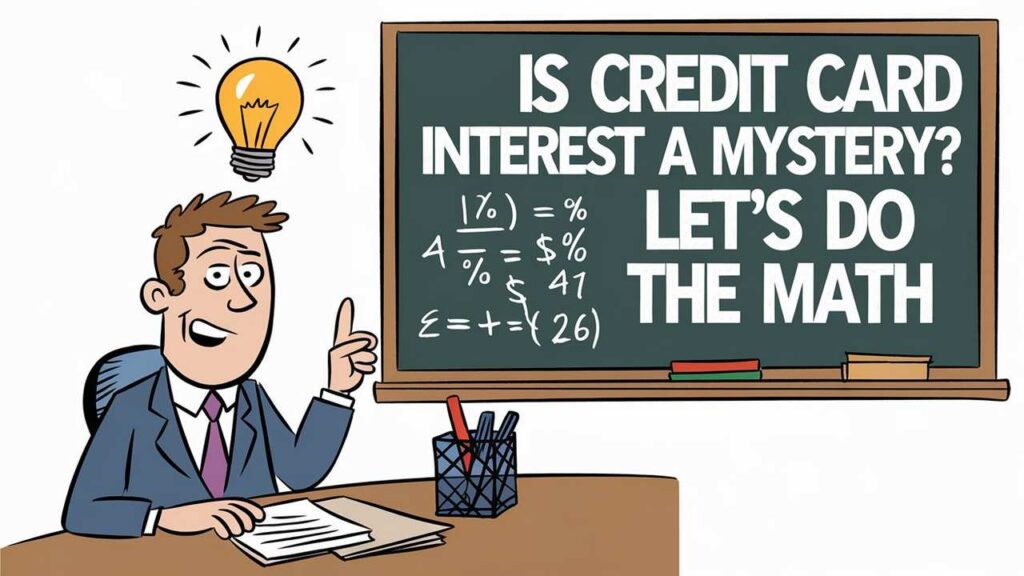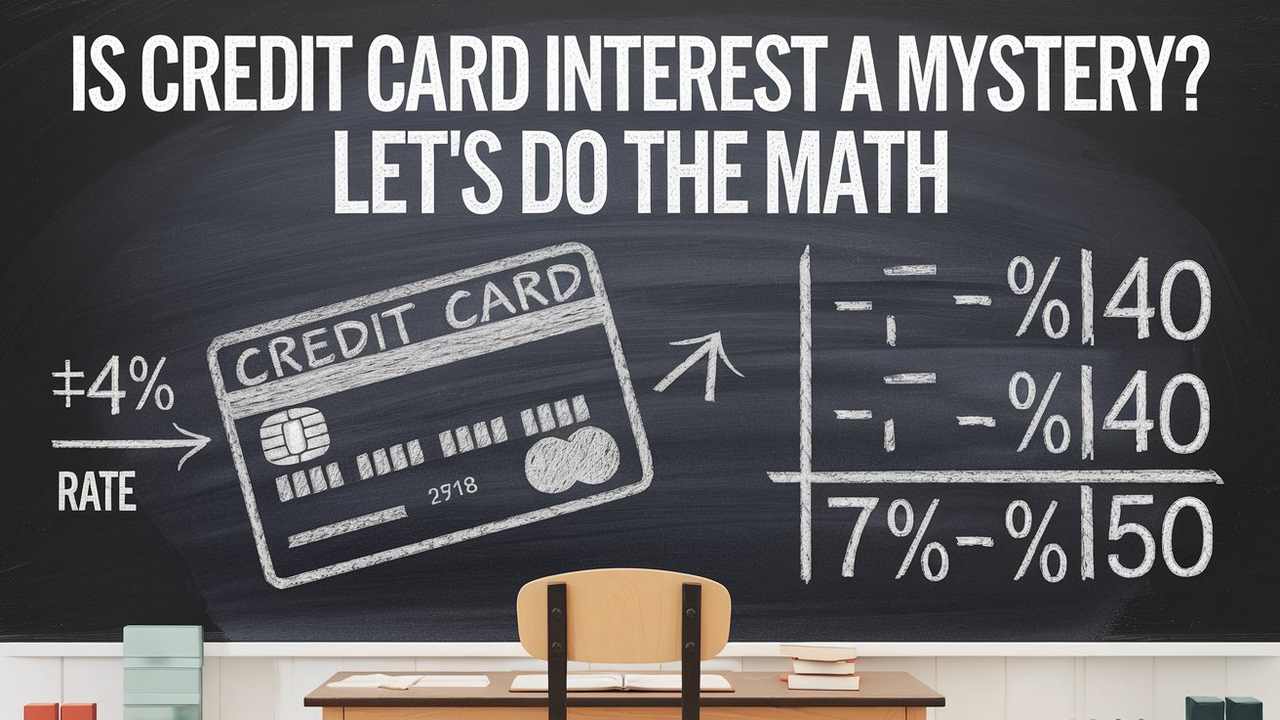The Enigma of Credit Card Interest
Unraveling the Mystery of Your Credit Card Statement
The labyrinthine world of credit card interest can often seem like an arcane puzzle. At first glance, your credit card statement might appear to be a cryptic scroll, filled with numbers, percentages, and charges that blend into an indecipherable haze. But behind the seemingly impenetrable jargon lies a logical structure, a mathematical framework designed to quantify the cost of borrowing. Dissecting your statement involves more than just skimming over the balance; it requires a meticulous examination of interest rates, fees, and payment terms. This deep dive will illuminate the often-overlooked aspects of your statement, shedding light on how each charge is calculated and how they affect your overall debt.

Why Credit Card Interest Feels Like Magic
Credit card interest often feels like financial alchemy, where small purchases quickly transform into enormous debt. The sense of enchantment lies in the compounding effect, a process where interest is charged on previously accrued interest. This magical multiplication can turn a modest balance into a mountain of debt faster than you can say “compound interest.” The trick is in understanding how this seemingly mystical process works, allowing you to demystify the financial sorcery and take control of your credit card costs.

The Basics of Credit Card Interest
What Is Credit Card Interest? A Simple Explanation
Credit card interest is the cost of borrowing money from your credit card issuer. When you carry a balance from month to month, you are charged interest on that outstanding balance. This interest is expressed as an Annual Percentage Rate (APR), which represents the yearly cost of borrowing. For example, if you have a 15% APR and carry a $1,000 balance, you’ll be charged $150 in interest over a year, assuming no payments are made. Understanding this basic concept is crucial for managing and minimizing your credit card expenses.
How Credit Card Interest Differs from Other Loans
Unlike traditional loans or mortgages, Credit card interest is typically higher and calculated differently. While loans often have fixed rates and clear repayment terms, credit card interest is usually variable and compounded. This means that interest rates can fluctuate, and interest is calculated daily on your average daily balance. Additionally, credit card debt tends to accrue faster due to the high APR and the frequent compounding, making it more expensive to carry a balance compared to other types of loans.

The Math Behind Credit Card Interest
How Interest Rates Are Calculated: A Deep Dive
Interest rates on credit cards are calculated using a formula that involves your Annual Percentage Rate (APR) and the average daily balance. The APR is divided by 365 days to determine the daily periodic rate, which is then multiplied by your average daily balance to compute the interest for a given period. This seemingly straightforward formula can result in surprisingly high interest charges, particularly if you carry a balance over multiple billing cycles.
The Role of APR in Your Credit Card Interest
The APR is a critical component in determining how much interest you will pay on your credit card balance. It represents the annual cost of borrowing, including both the nominal interest rate and any additional fees. A higher APR means you will pay more in interest over time. Credit card issuers often advertise low introductory rates, which can increase significantly after a promotional period, making it essential to understand the APR’s role in your long-term financial planning.
Compounding Interest: The Secret Sauce of Growing Debt
Compounding interest is where the real magic or rather, the financial peril occurs. When interest is added to your balance, it becomes part of the principal, and future interest is calculated on this larger amount. This compounding effect means that your debt can grow exponentially, especially if you only make minimum payments. Understanding how compounding works can help you grasp why credit card debt can escalate so quickly and highlight the importance of paying off your balance as soon as possible.

Decoding Your Credit Card Statement
Understanding the Fine Print: Interest Rate Details
The fine print on your credit card statement reveals crucial information about how interest is applied to your account. This includes details about your APR, any promotional rates, and how interest is calculated on cash advances versus purchases. By carefully reading this information, you can better understand how different transactions impact your interest charges and avoid unexpected costs.
How Minimum Payments Affect Your Interest Costs
Making only the minimum payment each month can significantly increase the amount of interest you pay over time. While it may seem like an easy way to manage your debt, minimum payments are often designed to prolong the repayment period, leading to more interest accrued. Understanding how minimum payments are calculated and their long-term impact on your debt can motivate you to pay more than the minimum and reduce your overall interest costs.

Fees and Penalties: The Hidden Charges That Add Up
Credit card statements are not just about interest rates; they also include various fees and penalties that can exacerbate your debt. Late fees, over-limit fees, and foreign transaction fees can all contribute to your financial burden. Recognizing these hidden charges and their impact on your total cost of borrowing can help you avoid unnecessary expenses and better manage your credit card usage.
Interest Calculations: Breaking Down the Formula
Daily vs. Monthly Interest Calculations: What’s the Difference?
Credit card interest can be calculated on a daily or monthly basis, which can affect the total amount of interest you pay. Daily calculations involve applying interest charges to your balance each day, while monthly calculations apply interest once a month. Daily compounding can lead to higher interest costs, especially if you carry a balance over an extended period. Understanding the difference between these methods can help you grasp how your interest charges are accumulated and plan accordingly.
How to Calculate Your Daily Periodic Rate
To calculate your daily periodic rate, divide your APR by 365 days. For example, if your APR is 18%, your daily periodic rate would be approximately 0.049%. This rate is then multiplied by your average daily balance to determine your daily interest charges. Knowing how to calculate this rate can help you better understand how your interest is accumulated and give you insights into managing your credit card debt more effectively.
Figuring Out the Impact of Your Balance on Interest
Your credit card balance directly impacts the amount of interest you pay. The higher your balance, the more interest you’ll accrue. To illustrate this, consider how different balances affect your monthly interest charges. For example, a $2,000 balance at an 18% APR will incur significantly more interest than a $500 balance. By monitoring and managing your balance, you can control your interest costs and avoid escalating debt.

Real-Life Examples and Scenarios
How a $1,000 Balance Can Balloon into Thousands
A $1,000 balance on a credit card can quickly grow into a much larger amount due to high-interest rates and compounding. For instance, if you only make minimum payments on a $1,000 balance with a 20% APR, it could take years to pay off the debt and cost you thousands in interest. This example highlights the importance of paying down your balance as quickly as possible to avoid the snowball effect of growing debt.
Case Study: Paying Only the Minimum Payment
Consider a case study of someone who consistently makes only the minimum payment on their credit card balance. Over time, the minimal payments may cover just the interest charges, leaving the principal amount largely unchanged. This scenario demonstrates how the minimum payment strategy can lead to prolonged debt and increased interest costs, underscoring the need for a more aggressive repayment approach.
The Cost of Carrying a Balance: Analyzing Different Scenarios
Analyzing various scenarios of carrying a balance on your credit card can reveal the true cost of debt. For example, compare the interest charges on a $1,000 balance with different APRs and repayment strategies. By examining these scenarios, you can gain a clearer understanding of how interest accumulates and how different payment strategies can affect your overall debt.
Strategies to Manage and Reduce Credit Card Interest
Tips for Paying Off Your Credit Card Faster
To pay off your credit card debt more quickly, consider strategies such as paying more than the minimum payment, targeting high-interest balances first, and making additional payments throughout the month. Utilizing these strategies can reduce your debt faster and minimize the amount of interest you pay.
How to Negotiate Lower Interest Rates with Your Credit Card Company
Negotiating lower interest rates with your credit card company is a practical way to reduce your interest costs. Start by researching current rates and preparing a solid case for why you deserve a lower rate. Contact your issuer, explain your situation, and request a rate reduction. Successfully negotiating a lower APR can significantly reduce the amount of interest you pay over time.
Balance Transfers: The Good, the Bad, and the Ugly
Balance transfers can offer a temporary reprieve from high-interest charges by moving your debt to a card with a lower APR or a promotional 0% APR. However, be cautious of balance transfer fees and the potential for higher rates after the promotional period ends. Evaluating the pros and cons of balance transfers can help you determine if this strategy is right for your financial situation.

The Psychology of Credit Card Spending
How Credit Card Interest Can Affect Your Spending Habits
Credit card interest can influence your spending habits by creating a sense of urgency or guilt. High-interest debt may prompt you to avoid using your card or make only minimum payments, impacting your overall financial behavior. Understanding these psychological effects can help you make more mindful spending decisions and avoid falling into debt traps.
The Emotional Impact of High Credit Card Debt
High credit card debt can have significant emotional effects, including stress, anxiety, and financial insecurity. The burden of mounting interest and debt can weigh heavily on your mental well-being. Recognizing the emotional impact of credit card debt is crucial for addressing both the financial and psychological aspects of managing your debt.
Debunking Myths About Credit Card Interest
Myth vs. Reality: Is Credit Card Interest Really That Bad?
Credit card interest is often viewed as a necessary evil, but separating myth from reality can provide a clearer perspective. For instance, some believe that all credit card interest is exorbitant, while others think that only minimal payments are necessary. Debunking these myths can help you understand the true cost of credit card interest and develop more effective strategies for managing it.
Common Misconceptions About APR and Interest Rates
Common misconceptions about APR and interest rates include the belief that all credit card rates are the same or that promotional rates are always beneficial. By clarifying these misconceptions, you can make more informed decisions about credit card usage and interest management.
Tools and Resources for Managing Credit Card Interest
Using Online Calculators to Track Interest Costs
Online calculators can help you track and project your interest costs by inputting your balance, APR, and payment amount. These tools can provide valuable insights into how your debt will grow over time and how different payment strategies can affect your interest charges. Leveraging these calculators can enhance your financial planning and debt management.
Apps and Tools to Help You Pay Down Debt
Numerous apps and tools are available to assist with debt management, including budget planners, debt reduction calculators, and payment trackers. These resources can help you stay organized, set goals, and monitor your progress in paying down credit card debt. Utilizing these tools can make the process of managing and reducing debt more manageable and efficient.
Planning for the Future
How to Avoid Interest Pitfalls in Your Financial Planning
To avoid interest pitfalls in your financial planning, create a budget that includes strategies for paying off debt, avoiding unnecessary expenses, and monitoring your credit card usage. Planning ahead can help you manage your finances more effectively and prevent falling into costly debt traps.
Building a Budget that Minimizes Credit Card Interest
A well-structured budget can minimize Credit card interest by allocating funds for debt repayment, setting spending limits, and tracking expenses. By incorporating debt reduction strategies into your budget, you can reduce interest costs and improve your overall financial health.
BOTTOM LINE: Taking Control of Your Credit Card Interest
Why Understanding Interest Can Save You Money
Understanding how Credit card interest works can lead to significant savings by enabling you to make informed decisions about your spending, payments, and debt management. Knowledge is power, and mastering the intricacies of interest calculations can help you reduce costs and achieve financial stability.
Next Steps: What You Can Do to Master Your Credit Card Costs
To master your credit card costs, take actionable steps such as paying off your balance more aggressively, negotiating lower interest rates, and using tools to track and manage your debt. By implementing these strategies, you can gain control over your credit card expenses and improve your financial well-being.
Frequently Asked Questions (FAQs)
Is 29.99 APR good or bad?
An APR of 29.99% is considered high and is generally unfavorable. Credit card APRs can vary widely, but rates approaching 30% are typically associated with higher costs of borrowing. If your card has this APR, it’s essential to be cautious with your spending and repayment to avoid significant interest charges. Source
What is 24% APR on a credit card?
A 24% APR on a credit card indicates that you will be charged 24% interest annually on any outstanding balance carried month-to-month. This is relatively high compared to average credit card APRs, which typically range from 15% to 20%. High APRs can lead to substantial interest charges if balances are not paid off promptly. Source
Is 26.99 APR high?
Yes, an APR of 26.99% is considered high. It signifies a significant cost of borrowing and can lead to substantial interest charges if you carry a balance. High APRs are often seen with credit cards for individuals with less-than-excellent credit scores or with cards designed for high-risk borrowing.
Is 12% a good credit card APR?
A 12% APR is relatively low compared to the average credit card rate, which typically ranges from 15% to 20%. This lower rate is advantageous as it reduces the cost of borrowing. However, whether it’s good depends on your credit profile and the terms of the card.
What does 39.9 APR mean?
A 39.9% APR is exceptionally high and indicates a very steep cost of borrowing. Such high APRs are usually found with credit cards designed for those with poor credit or as part of high-risk lending products. Carrying a balance on a card with this APR can result in significant interest costs.
What is the penalty for a 1-day late credit card payment?
The penalty for a 1-day late credit card payment typically includes a late fee, which can range from $25 to $40, depending on the card issuer. Additionally, your interest rate might increase, and a late payment could negatively impact your credit score.
Is it possible to never pay interest on a credit card?
Yes, it is possible to avoid paying interest on a credit card by paying off your balance in full by the due date each month. If you consistently pay your balance before the end of the grace period, you won’t incur interest charges on your purchases.
Is credit card interest monthly?
Credit card interest is often calculated on a daily basis but applied to your account monthly. The daily periodic rate is used to determine the interest accrued each day, which is then summed up and added to your balance at the end of the billing cycle.
Do you get charged interest if you pay minimum?
Yes, if you only make the minimum payment, you will still be charged interest on the remaining balance. Minimum payments typically cover the interest and a small portion of the principal, meaning the majority of your balance will continue to accrue interest.
Can I pay credit card without interest?
You can avoid paying interest by paying off your balance in full before the due date each month. This practice ensures you are not charged interest on your purchases, as most credit cards offer a grace period during which you can pay off your balance without incurring interest. Source
How much interest will be charged on a credit card?
The amount of interest charged on a credit card depends on your APR and the balance you carry. For example, with a $1,000 balance and a 20% APR, you would accrue approximately $200 in interest over a year if you do not make any payments.
How much credit card charges per month?
Credit card charges per month include interest on any outstanding balance, plus any fees or charges for services. The total amount varies based on your APR, balance, and any additional fees such as late payment fees or annual fees.
What if I pay only minimum due?
Paying only the minimum due will result in a prolonged repayment period and higher total interest costs. The minimum payment often covers just the interest and a small portion of the principal, so the remaining balance will continue to accrue interest.
Can a credit card have no interest?
A credit card can have no interest during a promotional period, such as a 0% APR offer on purchases or balance transfers. However, once the promotional period ends, the standard APR will apply, and interest will accrue on any remaining balance.
What happens if you make a late payment on a 0% interest credit card?
Making a late payment on a 0% interest credit card may result in the loss of the promotional 0% APR offer and an increase in your APR. Additionally, late payment fees and potential negative impacts on your credit score can occur.










